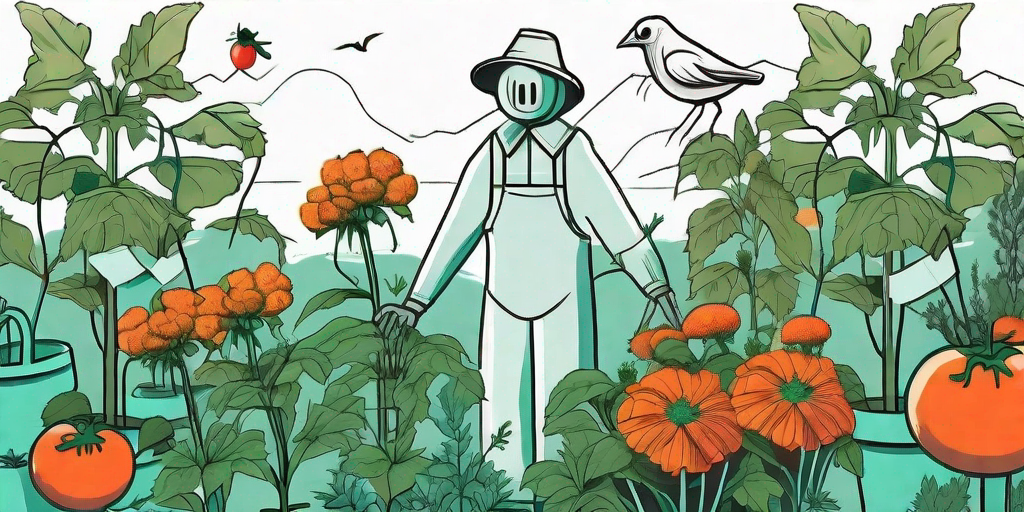
Tomatoes, the red jewels of the garden, are a favorite among green thumbs and foodies alike. But, as any seasoned gardener will tell you, these delicious fruits (yes, fruits!) are often the target of pesky bugs. Fear not, dear reader, for we have compiled a comprehensive guide to help you protect your tomato plants and ensure a bountiful harvest. So, put on your gardening gloves, grab your favorite hat, and let's dive in!
Understanding Your Enemy: Common Tomato Pests
Before we delve into the nitty-gritty of pest control, it's important to know what we're up against. After all, knowledge is power, and in this case, it's the power to keep your tomatoes bug-free.
There are several common pests that love to snack on your tomato plants. These include aphids, tomato hornworms, whiteflies, and spider mites. Each of these pests presents its own unique challenges, but don't worry, we'll cover how to deal with each of them in turn.
Aphids
Aphids are small, soft-bodied insects that can be green, yellow, brown, red, or black. They suck the sap out of your plants, causing the leaves to curl and yellow. If left unchecked, they can stunt your plant's growth and even kill it.
These little buggers reproduce quickly, so it's important to act fast at the first sign of an infestation. Aphids also secrete a sticky substance called honeydew, which can attract other pests and lead to sooty mold.
Tomato Hornworms
Tomato hornworms are large, green caterpillars that can decimate your tomato plants in a matter of days. They're called hornworms because of the horn-like protrusion on their rear end. Despite their size, these pests can be hard to spot because of their green color, which blends in with the plant's foliage.
These caterpillars are the larvae of the sphinx moth. They feed on the leaves and fruits of your tomato plants, leaving behind large, irregular holes and dark droppings.
Preventing Pests: An Ounce of Prevention is Worth a Pound of Cure
Now that we know what we're up against, let's talk about prevention. As the old saying goes, an ounce of prevention is worth a pound of cure. This is especially true when it comes to protecting your tomato plants from pests.
There are several strategies you can employ to prevent pests from setting up shop in your garden. These include practicing good sanitation, rotating your crops, using companion planting, and attracting beneficial insects.
Good Sanitation
Good sanitation is key to preventing pests. This includes removing dead or diseased plants, cleaning up fallen fruits and leaves, and regularly weeding your garden. These practices help eliminate potential breeding grounds for pests and can significantly reduce their numbers.
It's also a good idea to clean your gardening tools regularly. This can prevent the spread of diseases and pests from one plant to another.
Crop Rotation
Crop rotation is a simple but effective strategy for preventing pests. This involves changing the location of your tomato plants each year. By doing this, you can disrupt the life cycle of pests and prevent them from becoming established in your garden.
As a bonus, crop rotation can also improve soil health and fertility, leading to healthier, more productive plants.
Dealing with Infestations: When Prevention Isn't Enough
Despite your best efforts, you may still find yourself dealing with a pest infestation. Don't despair! There are several effective methods for dealing with pests, from natural remedies to commercial pesticides.
Remember, the key to effective pest control is early detection and prompt action. Regularly inspect your plants for signs of pests and act quickly at the first sign of trouble.
Natural Remedies
Natural remedies can be a safe and effective way to deal with pests. For example, a strong spray of water can knock aphids off your plants and disrupt their life cycle. You can also make your own insecticidal soap by mixing a few drops of dish soap with water and spraying it on the affected plants.
For larger pests like tomato hornworms, handpicking can be an effective method of control. Simply pluck the caterpillars off your plants and dispose of them. Just be sure to check your plants regularly, as these pests can quickly multiply if left unchecked.
Commercial Pesticides
If natural remedies aren't enough, you may need to resort to commercial pesticides. There are many options available, from organic options to synthetic chemicals. When using pesticides, always follow the manufacturer's instructions and use them sparingly to avoid harming beneficial insects.
Remember, the goal is to control pests, not eradicate them completely. A healthy garden is a balanced ecosystem, and some pests are a normal part of that balance.
FAQs
Why are bugs attracted to my tomato plants?
Bugs are attracted to tomato plants for the same reason we are - they're delicious! Tomato plants provide a rich source of food for many insects. Additionally, the green color and fragrant smell of tomato plants can attract bugs.
How can I attract beneficial insects to my garden?
There are several ways to attract beneficial insects to your garden. Planting a variety of flowers can attract pollinators like bees and butterflies. Certain plants, like marigolds and nasturtiums, can also repel pests. Additionally, providing a source of water and shelter can make your garden more attractive to beneficial insects.
What are some natural predators of tomato pests?
There are many natural predators of tomato pests. Ladybugs and lacewings feed on aphids, while birds and parasitic wasps prey on tomato hornworms. By attracting these beneficial creatures to your garden, you can help keep pest populations in check.
Conclusion
Protecting your tomato plants from pests can be a challenge, but with the right knowledge and strategies, it's a battle you can win. Remember, the key to successful pest control is prevention, early detection, and prompt action. So, arm yourself with these tips and say goodbye to those pesky bugs. Your tomato plants (and your taste buds) will thank you!











